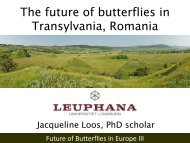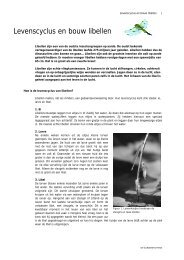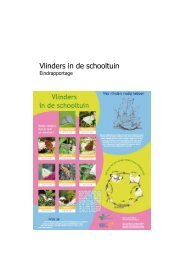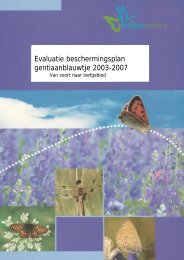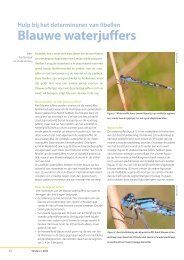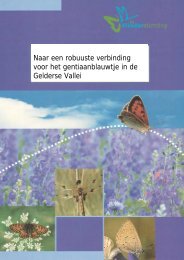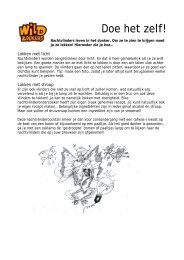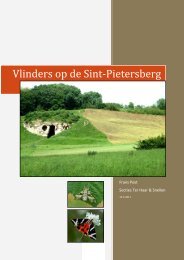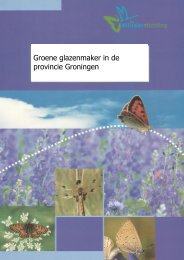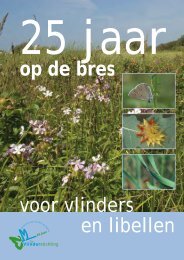Final Report October 2011 for the BBI-Matra/2008/015 ... - Vlindernet
Final Report October 2011 for the BBI-Matra/2008/015 ... - Vlindernet
Final Report October 2011 for the BBI-Matra/2008/015 ... - Vlindernet
Create successful ePaper yourself
Turn your PDF publications into a flip-book with our unique Google optimized e-Paper software.
Photo ©Süleyman Eksioglu<br />
6.6. (and 7.4.) Collect baseline monitoring data on butterflies at a selected<br />
priority PBA<br />
Following initial training in systematic data collection butterfly watchers were encouraged to<br />
identify and record all species seen during a field visit in order to provide basic monitoring of<br />
sites and species. Additionally, when opportunities arose, individuals participated in<br />
organised surveys.<br />
Details on <strong>the</strong> work:<br />
In 2009 and 2010, be<strong>for</strong>e <strong>the</strong> PBAs were confirmed and a single site could be selected,<br />
fieldwork aimed to ga<strong>the</strong>r in<strong>for</strong>mation on a range of sites, species and threats by visiting<br />
localities which were potential PBAs, or areas where <strong>the</strong>re were major data gaps.<br />
Potential PBAs – 11-18 July 2009<br />
Evrim Karaçetin and Hilary Welch <strong>for</strong>med a survey team of four toge<strong>the</strong>r with Didem<br />
Ambarlı (DKM Grassland Conservation Programme Coordinator) and Ümit Durdu (see 6.2<br />
above). The sites visited included two of <strong>the</strong> PBAs listed in <strong>the</strong> European inventory: Kopdağı<br />
and Palandöken Mountains (PBAs); plus Torul, Demirkaynak (type locality <strong>for</strong> <strong>the</strong> endemic<br />
Turkish False Argus [Aricia torulensis]) and Gölyurt Pass.<br />
Gaps in <strong>the</strong> data – May-July 2010<br />
Amasya area – 25-27 May 2010: Third most species rich area in Turkey with 145 species<br />
(Hesselbarth et al. [1995]); location <strong>for</strong> steppe fritillary (Euphydryas orientalis), last<br />
recorded 1903. Four areas around <strong>the</strong> city were visited and steppe fritillary was not<br />
recorded. Below 1400 m, in <strong>the</strong> areas likely to be most suitable <strong>for</strong> <strong>the</strong> steppe fritillary, <strong>the</strong><br />
natural grassland habitats were fragmented by cultivation, settlements and tree plantations,<br />
with some over-grazing, but <strong>the</strong>re were also intact areas of a reasonable size which were<br />
rich in species. Above 1400 m <strong>the</strong> habitats appeared well-managed and less threatened.<br />
Küre Mountains (Kastamonu and Bartın) – 7-11 June 2010<br />
Part of <strong>the</strong> area is a national park, thus an opportunity to contribute data and<br />
recommendations to <strong>the</strong> park’s management plan. A report on <strong>the</strong> fieldwork, including birds<br />
and butterflies, was submitted to <strong>the</strong> Directorate in September 2010.<br />
Steppe (Sivas and Malatya) – 26 June-2 July 2010<br />
One of <strong>the</strong> most threatened habitats in Turkey; important <strong>for</strong> many Agrodiaetus butterfly<br />
species – of which <strong>the</strong>re are more than 50 in Turkey, many of <strong>the</strong>m Data Deficient. Two<br />
localities, identified as priority <strong>for</strong> butterflies, were visited, to collect up to date in<strong>for</strong>mation<br />
on habitats, species and threats.<br />
Threatened species<br />
Work on rare or threatened species took place throughout <strong>the</strong> project.<br />
Mesopotamian blue (Polyommatus dama); Endangered<br />
8-10 and 24-29 July 2010<br />
Mesopotamian Blue is an endemic species, listed as Endangered by IUCN and last seen in<br />
2001 with one individual at a single locality. Two teams visited sites in Malatya and<br />
Adıyaman.<br />
Selected PBA – Middle East Technical University Campus<br />
Research into <strong>the</strong> biology of steppe fritillary (Euphydryas orientalis) Endangered<br />
During <strong>the</strong> Red List Workshop it was recognised that <strong>the</strong> foodplant and ecology of this<br />
species were unknown. Since steppe fritillary occurs on METU campus alongside marsh<br />
fritillary, Hilary Welch and Seda Emel Tek reared Euphydryas caterpillars feeding on teasel<br />
plants to discover which of <strong>the</strong> two species <strong>the</strong>y were. The 80 butterflies – all marsh fritillary<br />
– were released on METU campus in May 2010. Following this study it was considered<br />
extremely unlikely that <strong>the</strong> foodplant of steppe fritillary was also teasel.<br />
In early spring <strong>2011</strong>, five members of <strong>the</strong> yirtikpirtik e-group were involved in searches <strong>for</strong><br />
steppe fritillary caterpillars and, on 16 April many large Euphydryas caterpillars were found<br />
on Scabiosa argentea plants. Four caterpillars were collected, and by 2 May all had pupated,<br />
emerging as steppe fritillaries 28 days later.<br />
DE VLINDERSTICHTING & BCE <strong>2011</strong> | Butterfly Conservation in Turkey – <strong>Final</strong> report <strong>2011</strong> 47





